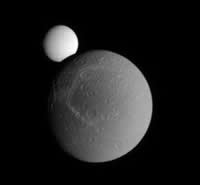Difference between Planets and Moons
Key difference: A planet is a large object that orbits around a star or a stellar remnant. Moons are the natural satellites of the planets. These natural satellites orbit around a primary body, mainly the planets or large enough asteroids.
include("ad4th.php"); ?>
 A planet is a large object that orbits around a star or a stellar remnant. This is mainly due to its own gravity and gravity of the star that allows the planet to have an orbit around the star. The orbit is usually elliptical in shape, mainly depending on the gravitational force of the planet and the star.
A planet is a large object that orbits around a star or a stellar remnant. This is mainly due to its own gravity and gravity of the star that allows the planet to have an orbit around the star. The orbit is usually elliptical in shape, mainly depending on the gravitational force of the planet and the star.
Also see the difference between Earth and other planets.
The gravitational force of the planet is strong enough that it leads the planet to be rounded, i.e. compound its matter in a spherical shape. A planet has also cleared its neighboring region of any other debris. The planetesimals, i.e. other debris, should either get absorbed into the planet, or if it big enough to have a gravitational force of its own, it might become a satellite of the planet, i.e. moon, or will just float away into space.
As per the International Astronomical Union (IAU), “A "planet" is a celestial body that: (a) is in orbit around the Sun, (b) has sufficient mass for its self-gravity to overcome rigid body forces so that it assumes a hydrostatic equilibrium (nearly round) shape, and (c) has cleared the neighbourhood around its orbit.”
include("ad3rd.php"); ?>
Hence, as per this definition, there are currently eight planets in our solar system: Mercury, Venus, Earth, Mars, Jupiter, Saturn, Uranus, and Neptune, in order of distance from the Sun.
Moons are the natural satellites of the planets. These natural satellites orbit around a primary body, mainly the planets or large enough asteroids. Natural satellites were rocks that had been left over after the solar system and the planets in it were formed. These rocks then either fell into an orbit around their nearest largest asteroid or planet or floated away into space.
Also see: The difference between asteroids and planets
 These natural satellites can range in sizes, some are bigger than planets. For example, Ganymede, a moon of Jupiter and Titan, a moon of Saturn are bigger in size than Mercury, which is a planet. Furthermore, it is not necessary that all planets have moons or have one moon: Mercury and Venus do not have moons at all; Earth has a single natural satellite, which we call, the Moon; Jupiter and Saturn have more than 50 to 60 moons; Neptune and Uranus have more than 20 moons; even Pluto, Haumea, and Eris, which are considered as minor planets or dwarf planets have various moons, Pluto has five known moons. Furthermore, there are more natural satellites being constantly discovered.
These natural satellites can range in sizes, some are bigger than planets. For example, Ganymede, a moon of Jupiter and Titan, a moon of Saturn are bigger in size than Mercury, which is a planet. Furthermore, it is not necessary that all planets have moons or have one moon: Mercury and Venus do not have moons at all; Earth has a single natural satellite, which we call, the Moon; Jupiter and Saturn have more than 50 to 60 moons; Neptune and Uranus have more than 20 moons; even Pluto, Haumea, and Eris, which are considered as minor planets or dwarf planets have various moons, Pluto has five known moons. Furthermore, there are more natural satellites being constantly discovered.
As of January 2012, there are 176 known moons orbiting six of the eight planets, eight orbiting three of the five dwarf planets, and there are 76 asteroids located in the asteroid belt, between Mars and Venus, that have satellites orbiting them. Many of these satellites are believed to be capable of sustaining life. Some have proof of ice and water, while Titan even has an atmosphere.
Still, the main difference between planets and moons is the fact that planets orbit around the Sun, while moons orbit around their planets or dwarf planets or asteroids or primary objects. Furthermore, the natural satellites also orbit around the Sun, in collaboration with their primary objects, For example, the Moon orbits around the Earth, but as the Earth orbits the Sun, the Moon also orbits the Sun, while following the Earth.
Image Courtesy: nineplanets.org, scienceblogs.com









Comments
Anonymous
Fri, 02/16/2018 - 00:43
By definition, a planet is something that revolves around a star, like the Sun. Since the Moon revolves around the Earth, and not the Sun, it cannot be classified as a Planet. A moon is something that revolves around planets, which in turn revolved around the Sun.
dbadmin
Sat, 03/10/2018 - 14:11
Add new comment